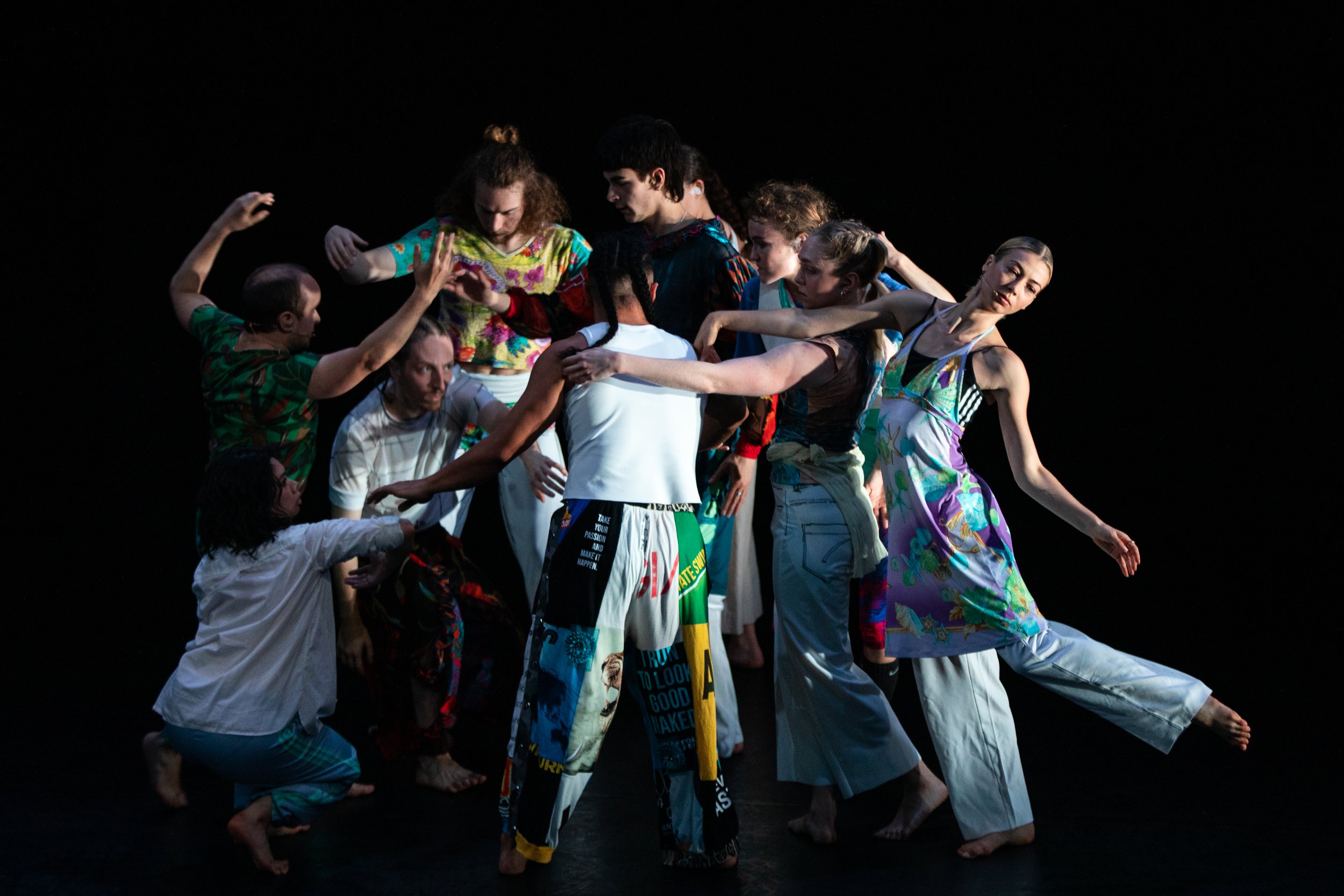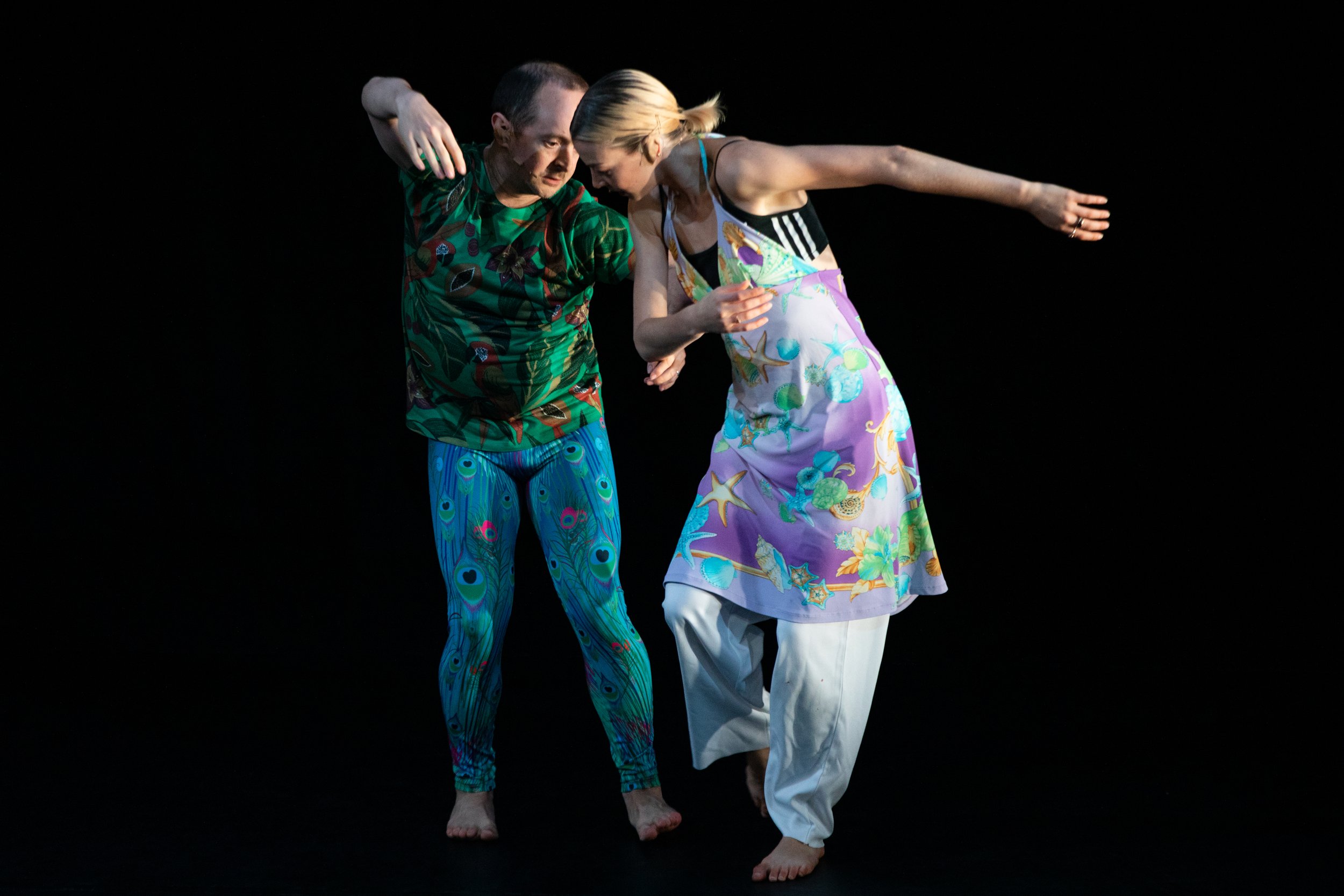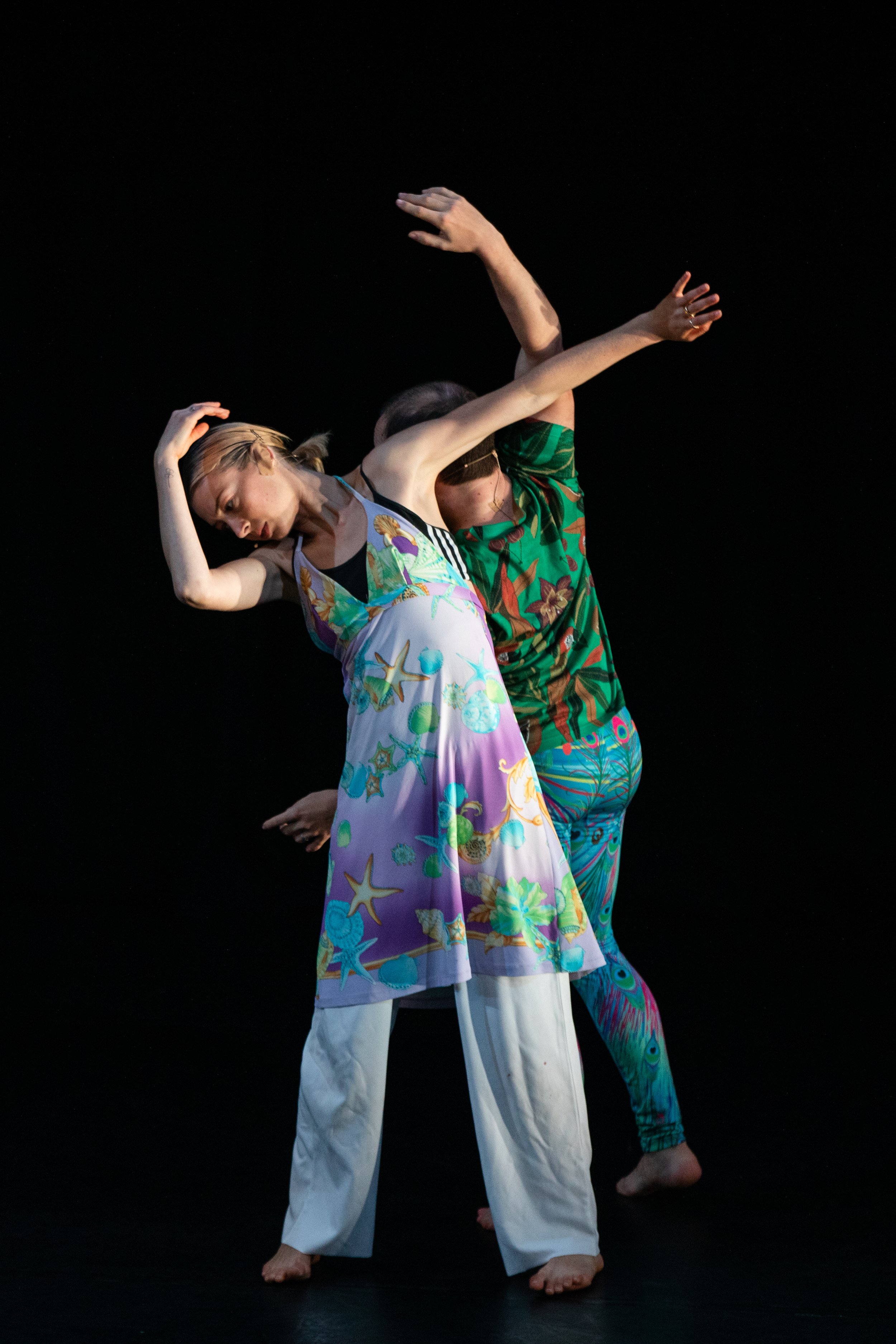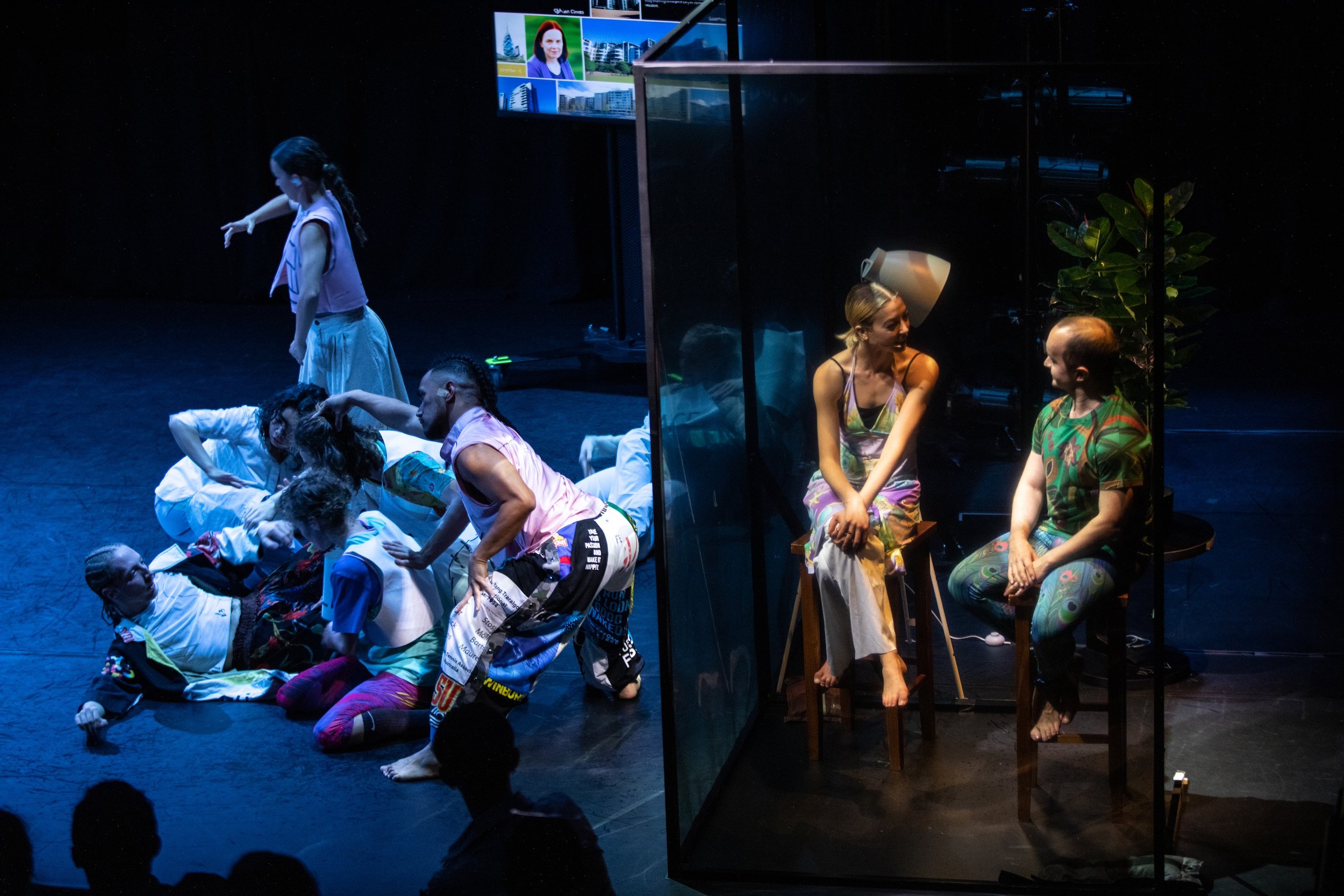
PLAGIARY
Sydney Opera’s Houses series UnWrapped presented “An ongoing series dedicated to uncovering the best independent creators. UnWrapped hands over the stage and introduces audiences to an eclectic panorama of the finest original performances by groundbreaking and unique local artists”. This series of UnWrapped was co-curated by Sydney Opera House’s Head of Screen, Stuart Buchanan and former Director of Programming, Fiona Winning. UnWrapped’s Plagiary asks ‘What happens when artificial intelligence is calling the creative shots?’. The immersive work combines contemporary dance, animated visuals, A.I. and 10 live performers in a bold new exploration of form and live performance experience. Plagiary cracks open a space to deepen our knowledge of embodiment. It champions the human body as one of the final entities untouched by artificial intelligence. A new show is improvised each night from scratch, as ten exceptional contemporary dancers become vessels for unpredictable directives, dictated by a computer voice presence. Acclaimed media artist Sam Mcgilp crafts new visual worlds of AI video for every performance. The audience is invited to delve further into this collaboration between human and machine. Follow the AI prompts via an onstage screen displaying the text that directs the performance. Or wear custom glasses to mask the text – the choice is yours.
<May I cue this dance?>
“This performance has never been performed and is the one and only time it will be performed”
The AI dialogue rang through the Studio at the Sydney Opera House as my friend and I settled into our seats for the opening night of UnWrapped’s Plagiary, a performance that would be one of many debuts. As the dancers dressed themselves from a selection of 90 garments designed by costume designer Andrew Treloar and pieces of their own, the audience was introduced to the AI dialogue prompts that would drive the next 50 minutes of performance. To engage or not to engage with the prompts, as they scrolled down the screen, was a choice left to the audience, each of us armed with a pair of glasses to block out the AI text that exposed the guiding algorithms at play. Whilst tempted to absorb it all as a pure dance work, I let curiosity get the better of me and found myself trying to lap up every word as the dancers allowed themselves to be guided to centre stage. As director, choreographer, creative coder and sound designer of Plagiary, Alisdair Macindoe explains, the audience is either invited to don the glasses and experience a “very ephemeral, physical dance realisation of the ideas”, where the mechanics are hidden or read the instructions as you are “invited into the process of dance making…[by] seeing text converted into movement”. The cast of ten contemporary dancers being fed in ear prompts to facilitate a constructivist experience where AI text is embodied by the dancers and made alive into a cohesive and coagulated piece of contemporary performance.
Poised at the intersection of technology and arts, Plagiary brings the 4th wall crashing down both through its practice and the invitation to film and photograph, positioning us to observe and speculate rather than purely enjoy what eventuates before us. As the dancers launched into their collaborative performance of provoked interaction, communal reaction and bodily interpretations ‘The Cycle by Hanya Holm’ began to unfold before us.
The work of Plagiary springboards off the fundamental work Alisdair Macindoe did in 2019-2021 developing the training and creation tool, A.I.D., to facilitate computer generated choreographic instruction. Alisdair Macindoe is an independent multidisciplinary choreographer with two decades of dance (36 works) and sound design experience (48 works) and is the leading force behind Plagiary. His extensive knowledge and experience with both independent and collaborative work, and his level of empathy of a performer's role after decades in industry, allowing him to generate a system and ‘greater large language model … built from a very long history of understanding what is like to be on stage improvising and performing ideas’. His current interest in extending the boundaries of choreographic practice to explore automated dance and Artificial Intelligence led him to create Plagiary where the ‘crux of the piece is; trying to describe this love of a performative moment in a computer program’.
The base concept itself leverages on pre-exist[ing] traditions in dance. “Telling a bunch of dancers a score verbally is…an ongoing practice that has been going on for…an uncountable amount of time” Alisdair credits. However, Plagiary adds a unique layer by utilising a computer generated voice to instruct the performances content that is procedurally generated using algorithms and AI. Ultimately, presenting a choreographic metaphor, through its iterative process, that communicates the attention economy and the fleeting feeling of ‘nowness’ in a technologically driven world.
A few days prior I had been privileged enough to watch the initial rehearsals of Plagiary, only the second time the dancers had rehearsed, or more so, performed together. The newness of it all, offering dancers like Siobhan Lynch, ‘excitement, playfulness and allow[ing them] to explore on a deep layer, how as individuals, we can work together as a group to create a dynamic performance’. Alisdair’s choice to make a situational piece that takes on a new cast per location made to “contextualise an exploration of [the] relationship between technology and body”.
As the play got underway the initially puppet-like movements oscillated between moments of restraint and indulgence as the element of AI control was evident yet didn’t override the agency of the dancer. Some audience members became entranced by the fluidity of such a reactionary piece, whilst others were humoured by the quirks that began to emerge and splutters of audible laughter could be heard in the Studio. Alisdair speculates it’s because there is something “playful about the piece or beautifully simple where it just makes you get a bit giggly”. The playful energy, a potential outcome of the trust put in the dancers to interpret the text in a certain way and the free will afforded in allowing each dancer to follow their own motive. Presenting the dance as a part of a larger system invites audiences to connect with the dancer on the shared experience of meaning making through movement. Alisdair says
“we give it meaning as we watch, by participating in the activity of watching we can choose to attribute meaning to it”.
As I watched the BTS rehearsal I spoke with Alisdair about how he sees Plagiary as “a form of self expression that I feel my personality and knowledge and artistry is wrapped up in”. Our conversation dilated on the performance as a "collaboration" of humans and AI and the gaps between meaning, interpretation and truth in the realm of AI.
As an individual who never joined social media at all, a rarity amongst modern day individuals, especially for creatives like himself, Alisdair was surprised that it has taken this long for many artists to flee platforms such as Instagram as the distrust in AI has steadily increased. Thus it may seem contradictory to some that he should actively choose to engage such a tool. “There is a lot to be concerned about but the reality [is] that these tools and these systems exist…I am just lucky in that I have a practice in generative algorithmic art making that extends over a decade long” Alisdair says. His deep understanding of AI and hours upon hours of work spent tending to AI to manipulate its strengths and weaknesses is far from the efficiency trope we often associate with it. The convoluted systems that Alisdair has built in collaboration with AI “began with several years of experiments building grammar maps and sentence generators”, consequently building “metastructures that can house the choreographic ideas and content [and] section generators”. Rather than AI doing a job on his behalf, Alisdair is embedded within the structures of the AI as he “wrote every word into a program and … created… structural ideas that I train the AI to do, so the level of creative freedom that the AI has is quite directed by my choreographic voice and creative voice”. Alisdair’s personal touch and human involvement is evident not only for the dancers who feel “some tether to the direction coming from him through the system” but also through the humanistic voice programmed into the show. The use of ‘us’ and ‘we’ by the AI, a very inclusionary form of language that builds a community out of all present for the performance; director, dancers and audience alike. All engaged in the unfolding script of chained prompts, a social contract of sorts between us human bodies and the overarching superintendence of the AI, indirectly Alisdair.
Alisdair mediated the delicate relationship between technology and his long history in performing dance to produce an artwork that changes the nature of choreography from something rehearsed and practised to something quite imminent with a ‘very strong sense of immediacy and nowness’. A step further from improvisation as it becomes a reactionary conversation with the AI rather than something whisked out of the dancer's own mind. Dancer Siobhan describes how she has “never experienced a live performance opportunity with no previous creation and development time beforehand, or even extended rehearsal time. The unusual format of this situation allowed us as a group to jump straight into the excitement of performing which encouraged us all to acknowledge that there was no right or wrong in the situation”. Alisdair seconded her in reminding the dancers post rehearsal not to ‘sign up to the idea of failing’.
Having worked with the large language model for many hours, weeks and months, he was able to understand its beneficial mechanisms, quoting that “after a long period of time you might find a sense of collaboration with something that is not a human”. Even when, in a creative sense, working with the large language model as a collaborative entity, Alisdair takes whole ownership for it’s eventuating outcomes as he believes “Anything that is produced using AI needs to be attributed to the person who is…putting it into the world, because the risk of it causing positive or negative impact needs to be attributable and people need to be held accountable for any actions they take”.
In the midst of the performance, our attention is pulled away from the flurry of prompts and concurring dances as a presentation led by Joel Fenton begins ‘a lecture about the research material behind the show’, mimicking that of a corporate meeting or TED talk. Metaphysical philosophy, esoteric concepts and general truths are communicated to us through the voice of Joel as the AI weaves a story of circadian cycles, ‘rhythmic essence’ and ‘life’s relentless march through time’, all accompanied by a technical looking powerpoint. The AI invites Siobhan to join Joel as the pair begin a blatantly plagiarised biographical interlude between two artists who “supposedly” created the show, in which Siobhan inhibits the spirit of the late Hanya Holm. Alisdair uses the spoken word element to give insight into the legacy of the previous generations of artists in a postmodern meta way. Presenting the character onstage so good at faking reality you forget she is being fed lines, yet, it was a challenging feat for Siobhan ‘to repeat text in real time and act”. She says it was an
“unusual split between how I as ‘Siobhan’ would present the information and how the AI/other persona would engage with audiences….I felt some part of my mind completely pause my inner thoughts in order to hone my full attention on embodying another character”.




Dancing along the line of truth and fiction, and in a twisted way presenting as an embodied deep fake, the dialogue encapsulates much of what Alisdair wanted to achieve with “playing with what truth is in this work”. “As an artist I think it is important to be able to play with reality and non-reality in work. I am not…searching for ultimate truth. More searching for a way to express myself in a world that is…filled with disinformation”. As the performance continued the name tags that initially identified the dancers amongst the AI prompts began to drop off as their names began to take less importance and the dance took over. The speed of the prompts still flooded both performer and audience with little time to process one idea before the next. Not an unfamiliar state when considering the information saturation and overbearing form of stimulation we engage with daily. The tempo encapsulating moods, ideas and perspectives Alisdair aims to discuss through his artistry such as attention economy and the impact of social media on shortening not only dance but music <insert *clock app*>. As a dancer the pace forced Siobhan to embrace the chaos and take every offer without over analysing her own ‘unique artistic movement language’.
“The rapid speed at which prompts were given helped to maintain the momentum of the ‘conversation’ as a question-and-answer format with the AI system. I felt less critically and hyper observant of my artists choices... I acted upon first impulse, staying true to the authenticity of my responses. This left less time to process the information which was both a creative challenge and artistic liberty”.
When considering the worldbuilding element of the Plagiary and its perceived heavy reliance on verbal instruction, I came across a saying that
"Language is more often than not ambiguous - though it feels accurate" [Cargo]
Which for me encapsulated the spectrum of ambiguity to accuracy, in the gap of interpretation, between the AI given prompt and dancers performance; how the prompt may seem like a boundary that follows the “traditions and teachings of learning dance around obedience and discipline” but it is just as fluid and ambiguous as free form improvisation. Additionally, on a secondary layer, how the meaning may emerge from how it translates and how deeply it resonates with the audience. Alisdair attributed this to the concept behind the “‘death of the writer’;... the meaning making of material is actually in the hands of the person receiving the material not the person that has been authoring it, after it has been made”. His willingness to ‘let go lightly’ to his choreographic authority as he “really cares about it but also let it go and let it free because that is how to really love something”. The unrehearsed nature of Plagiary creates unilateral or egalitarian power systems between choreographer and dancer as each execution of the performance is a debut and thus permits autonomy and entrusts an element of the storytelling control with the dancer. As Siobhan states “I still hold a sense of artistic agency as the AI program only provides the instruction, but I am still in power of my response, interpretation and thus action”, ultimately retaining artistic ownership.
As a collective chaos in the final minutes unfurled beneath the screen, dystopian imagery of melding desserts, hourglasses and cyclical waves blend across the screen and the dancers combine as one moving system. The laughter has been replaced with earnesty as the audience anticipates the climax of what will have been 50 minutes of expeditious prompts and arduous performance. A weird, fascinating system that demonstrates how AI “can assist our creative potential…by providing a bigger capacity for artistic possibilities…the initial spark that contributes to a growing creative fire” as said by Siobhan. The computer generated voice reminds us that ‘time does not forget nor sleep and will outlive us all’ which airs an eerie sentiment that could apply to AI itself.
As I left the theatre my mind stretched to wonder if Plagiary was just an extension of or amplified version of what we do in our everyday - computers and phones give us prompts, we respond in a certain way just as these dancers had responded and interpreted AI prompts. Are we just as bizarrely caught up in systems of control and forms of long standing social contract?
Plagiary was a transaction of ideas and open dialogue that engaged all in an exercise of meaning making in an increasingly convoluted world. Making clear the solutions that define the concealed illusion many of us don’t dare expose.
“Thank you for dancing with me.”
Presented by Insite Arts and Sydney Opera House.
PLAGIARY | 12 - 14 September
Studio, Sydney Opera House
Cast and Credits:
UnWrapped Programming | Stuart Buchanan and Fiona Winning
Concept, Direction, Choreography, Text, Coding, Sound Design And Set Design | Alisdair Macindoe
Video Design, Image Design and Coding | Sam Mcgilp
Software Development, Head Coder | Chris Chua
Costume Design, Prop Design | Andrew Treloar
Lighting Design | Amelia Lever-Davidson
Production Management | Zsuzsa Gaynor Mahaly
Producer | Penelope Leishman, Insite Arts
Performers | Sam Beazley, Franky Drousioti, Joel Fenton, Josh Freedman, Allie Graham, Tara Hodge, Grace Lewis, Siobhan Lynch, Frances Orlina and Sam Osborn
Event Photography | Yael Stempler
Quotes sourced from curatorial interview with Alisdair Macindoe and Siobhan Lynch.






